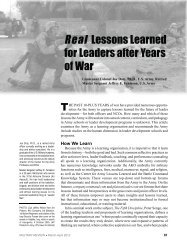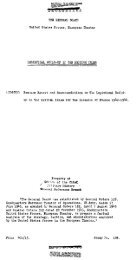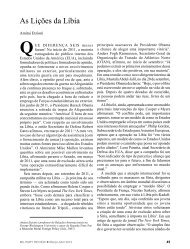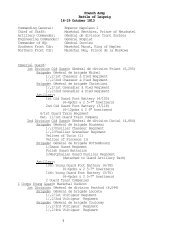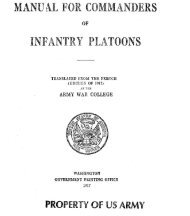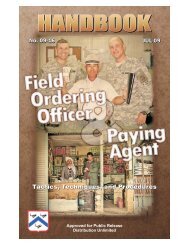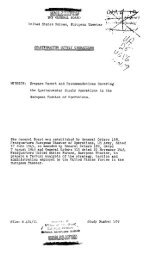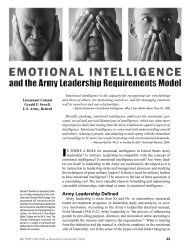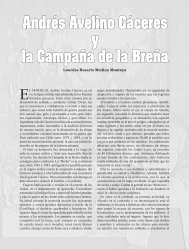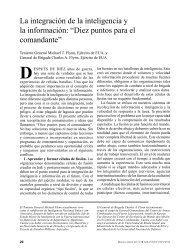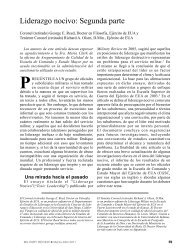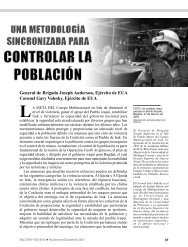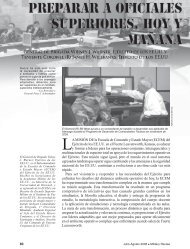Armor Magazine Counterinsurgency Selected Works - US Army
Armor Magazine Counterinsurgency Selected Works - US Army
Armor Magazine Counterinsurgency Selected Works - US Army
You also want an ePaper? Increase the reach of your titles
YUMPU automatically turns print PDFs into web optimized ePapers that Google loves.
City) and An Najaf, it became clear that the ultimate task organization<br />
of choice depended on the enemy threat. Patterns of employment<br />
of the combined arms team that both solidified and<br />
challenged existing doctrine were also made clear.<br />
The grid-like pattern of Al Tharwa presented an interesting tactical<br />
challenge to the soldiers and leaders of 2d Battalion, 5th<br />
(2-5) Cavalry Regiment (TF Lancer), 1st Brigade Combat Team,<br />
1st Cavalry Division, Fort Hood, Texas. As Muqtada’s militia<br />
began actively attacking coalition forces, TF Lancer worked rapidly<br />
to defeat the insurgent uprising while protecting its soldiers.<br />
As its primary avenue of approach, the enemy chose side street<br />
alleys, which Bradley Fighting Vehicles (BFVs) and M1A2 sys-<br />
Alley<br />
Alley<br />
Figure 1<br />
Street<br />
Direction of Attack<br />
3-5 mph<br />
Vehicle Distance: METT-TC<br />
(Alley to Alley)<br />
= M1A2SEP = M2A3<br />
“The commander’s independent sight<br />
systems offset the protective measure<br />
of vehicles moving through the city with<br />
hatches fully closed. The second sight<br />
afforded another field of view, allowing<br />
the gunner to primarily observe enemy<br />
alleys. Instead of the commander being<br />
relegated to what the gunner was<br />
observing, or struggling to gain situational<br />
awareness through vision blocks,<br />
he became an integral part of the vehicle<br />
and patrol team by providing coverage<br />
of secondary enemy avenues of<br />
approach, oriented forward of the vehicle<br />
or toward the opposite flank vehicle’s<br />
immediate rooftops, providing highangle<br />
coverage.”<br />
tem enhancement package (SEP) tanks<br />
could not negotiate due to sheer width and<br />
obstacles such as disabled civilian vehicles<br />
and air-conditioning units. As these<br />
vehicles progressed throughout the city,<br />
the militia would attack their flanks, seeking<br />
to disable them with IEDs, RPGs, and AK47s.<br />
U.S. <strong>Army</strong> Field Manual (FM) 3-06.11, Combined Arms Operations<br />
In Urban Terrain, Appendix C, states: “If isolated or<br />
unsupported by infantry, armored vehicles are vulnerable to enemy<br />
hunter/killer teams firing light and medium antiarmor weapons.<br />
Because of the abundance of cover and concealment in urban<br />
terrain, armored vehicle gunners may not be able to easily<br />
identify enemy targets unless the commander exposes himself<br />
to fire by opening his hatch or by infantrymen directing the<br />
gunner to the target.” 2<br />
Initially, following standard doctrine, the task force moved<br />
throughout the city in column or staggered-column formations,<br />
assigning typical 360-degree sectors of fire to cover all enemy<br />
avenues of approach. However, with the vertical firing platforms<br />
of rooftops and the coordinated attacks on both flanks<br />
through use of alleys, the task force had to rapidly adapt to the<br />
emerging enemy threat.<br />
The task force quickly learned to move throughout the city in<br />
protected mode (buttoned up) and maximize the capability of the<br />
dual sights provided by the M1A2SEP, equipped with the gunner’s<br />
primary sight and the commander’s independent thermal<br />
viewer (CITV), and the M2/3A3 improved Bradley acquisition<br />
subsystem (IBAS) with the commander’s independent viewer<br />
(CIV). As shown in Figure 1, their refined movement-to-contact<br />
formation resulted in a rolling battleship of armored vehicles in<br />
a “box” formation, moving in a deliberate, methodical progression<br />
through the main streets of Al Tharwa, maximizing the protection<br />
of the armor packages. 3 Success relied on the skill of the<br />
driver, the armor package of the M1A2 and the latest generation<br />
M2/3A3, and the dual-sight capability afforded by the vehicle<br />
upgrades.<br />
Moving buttoned up in a pure mechanized/armor formation, the<br />
combat patrol would reposition at the release point into a rectangular<br />
formation of at least six armored vehicles. Moving vehicles<br />
parallel to each other created an artificial set of interior<br />
lines to protect the exposed flank of the opposite vehicle and allow<br />
a full three-dimensional, 360-degree coverage of the constantly<br />
shifting battlespace.<br />
The commander’s independent sight systems offset the protective<br />
measure of vehicles moving through the city with hatches<br />
fully closed. The second sight afforded another field of view, al-<br />
48 — September-October 2008



